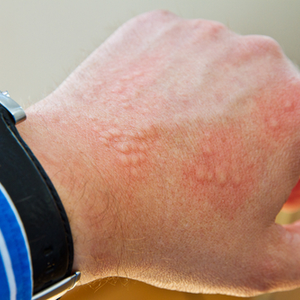
What is hives
Hives (urticaria) are one of the most common skin diseases and occur acutely or chronically. Hives are accompanied by the typical formation of wheals, which cause intense itching, but are not contagious. In some cases, hives can also cause swelling of the mucous membranes.
What causes hives?
In most patients, hives occur in episodes and are not triggered by any external factors. Doctors call this spontaneous urticaria, which can be caused by an infection or rare intolerances. There is a difference between spontaneous urticaria and so-called inducible urticaria. In inducible urticaria, the wheals are triggered by one or more external stimuli. These can be cold, heat or pressure, for example.
The rash typical of hives is caused by the production of certain immune cells called mast cells. The mast cells are usually formed by a previous reaction to a pro-inflammatory messenger substance. In particular, the tissue hormone histamine is one such messenger substance and is mainly responsible for the typical symptoms of hives, i.e. the formation of wheals as well as severe itching, redness and swelling of the skin.
What are the symptoms of hives?
Hives are manifested by the so-called wheals. These are skin-coloured to whitish swellings on the surface of the skin that are filled with a fluid. In some cases, the edges of the wheals may also have an inflammatory redness. If two wheals are very close together, they can also become a large swelling. As a rule, the wheals itch and burn very intensely, as if the skin had come into contact with stinging nettles. This is where the word urticaria comes from, as nettles are called urtica in Latin. In rather rare cases, hives are manifested by deeper swellings called agioedema. Agioedema usually occurs on the soles of the feet, the palms of the hands and the face. Unlike wheals, agioedema does not usually cause itching. Instead, patients complain of a feeling of tightness and/or a painful burning sensation.
What are the different forms of hives?
Doctors distinguish between the following different types of hives. They usually occur separately. Rarely, however, two or more of the subtypes can occur at the same time.
- spontaneous hives: H ives and/or angioedema form without any apparent external trigger. Depending on how long it takes for the wheals or angioedema to disappear, a distinction is made between spontaneous acute and spontaneous chronic hives.
- spontaneousacute urticaria:A specific trigger for spontaneous acute urticaria can often not be identified. However, many patients also suffer from an acute infection of the digestive tract or the respiratory tract, which is why doctors see a connection between the two. Also the intolerance of certain foods cannot be excluded. However, spontaneous acute hives last less than six weeks.
- spontaneouschronic hives:Hives that last longer than six weeks are called chronic urticaria. The symptoms can be either continuous or recurrent. The main triggers of spontaneous chronic urticaria are chronic infections, autoimmune reactions or hypersensitivity.
- physical hives: are triggered by physical stimuli such as cold, heat or pressure. Physical hives only occur in about 10 percent of all cases.
- other forms of hives: occur in less than 10 per cent of all sufferers and are therefore rather rare. Other forms of hives can be caused by physical exertion, contact with water or excessive sweating.
How can hives be treated?
The choice of treatment depends on the type of hives and the severity of the symptoms. For example, hives can be treated with medication. Antihistamines are often used to inhibit the effect of histamine. In most cases, however, the hives will disappear within 24 hours, even without treatment. They may be replaced by new hives on other parts of the body. In order to treat hives permanently, it is important, especially in cases of inducible urticaria, to know the trigger and to avoid it in the future. This can include certain foods, for example, but also medications.
A so-called habituation therapy (hardening) can also be considered as a treatment for hives and is mainly used when antihistamines do not provide relief and light could be identified as the trigger of the hives. Within habituation therapy, the skin should be specifically exposed to sunlight in order to develop a tolerance to sunlight in this way. The habituation therapy can also be used to get the skin used to cold. For example, cold showers should be taken regularly.
